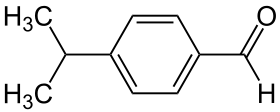Cuminaldehyde
 | |
| Names | |
|---|---|
| IUPAC name
4-(1-Methylethyl)benzaldehyde | |
| Other names
Cuminaldehyde p-Isopropylbenzaldehyde 4-Isopropylbenzaldehyde Cuminal Cumaldehyde | |
| Identifiers | |
| 3D model (JSmol) |
|
| ChEBI | |
| ChemSpider | |
| ECHA InfoCard | 100.004.107 |
| KEGG | |
| RTECS number | CU7000000 |
| UNII | |
| |
| |
| Properties | |
| C10H12O | |
| Molar mass | 148.21 g·mol−1 |
| Appearance | Colorless oil |
| Density | 0.978 g/cm3 |
| Boiling point | 235.5 °C (455.9 °F; 508.6 K) |
| Insoluble | |
| Hazards | |
| R-phrases (outdated) | R22 |
| S-phrases (outdated) | S36/37 |
| NFPA 704 | |
| Flash point | 93 °C (199 °F; 366 K) |
| Related compounds | |
| Related compounds |
Benzaldehyde Cumene Cuminol |
| Except where otherwise noted, data are given for materials in their standard state (at 25 °C [77 °F], 100 kPa). | |
| | |
| Infobox references | |
Cuminaldehyde, or 4-isopropylbenzaldehyde, is a natural organic compound with the molecular formula C10H12O. It is a benzaldehyde with an isopropyl group substituted in the 4-position.
Cuminaldehyde is a constituent of the essential oils of eucalyptus, myrrh, cassia, cumin and others.[1] It has a pleasant smell and contributes to the aroma of these oils. It is used commercially in perfumes and other cosmetics.
It has been shown that cuminaldehyde, as a small molecule, inhibits the fibrillation of alpha-synuclein,[2] which, if aggregated, forms insoluble fibrils in pathological conditions characterized by Lewy bodies, such as Parkinson's disease, dementia with Lewy bodies[3] and multiple system atrophy.[4]
Cuminaldehyde can be prepared synthetically by the reduction of 4-isopropylbenzoyl chloride or by the formylation of cumene.
The thiosemicarbazone of cuminaldehyde has antiviral properties.
References
- 1 2 Merck Index, 11th Edition, 2623
- ↑ Morshedi D; Aliakbari F; Tayaranian-Marvian, Fassihi; Pan-Montojo, Pérez-Sánchez (Sep 2015). "Cuminaldehyde as the Major Component of Cuminum cyminum, a Natural Aldehyde with Inhibitory Effect on Alpha-Synuclein Fibrillation and Cytotoxicity.". Journal of Food Science. 80 (10): H2336–H2345. PMID 26351865. doi:10.1111/1750-3841.13016.
- ↑ Arima K, Uéda K, Sunohara N, Hirai S, Izumiyama Y, Tonozuka-Uehara H, Kawai M (October 1998). "Immunoelectron-microscopic demonstration of NACP/alpha-synuclein-epitopes on the filamentous component of Lewy bodies in Parkinson's disease and in dementia with Lewy bodies". Brain Res. 808 (1): 93–100. PMID 9795161. doi:10.1016/S0006-8993(98)00734-3.
- ↑ Arima K, Uéda K, Sunohara N, Arakawa K, Hirai S, Nakamura M, Tonozuka-Uehara H, Kawai M (November 1998). "NACP/alpha-synuclein immunoreactivity in fibrillary components of neuronal and oligodendroglial cytoplasmic inclusions in the pontine nuclei in multiple system atrophy". Acta Neuropathol. 96 (5): 439–44. PMID 9829806. doi:10.1007/s004010050917.
